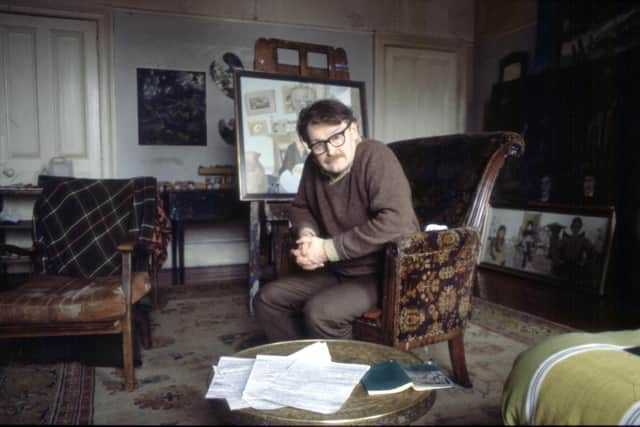Alasdair Gray's Lanark is an iconic book that deserves its own day of celebration – Laura Waddell


Spearheaded by archivist Sorcha Dallas and the Alasdair Gray Archive, it’s an opportunity to revisit the legacy of this iconic Scottish book.
In his introduction to the 2007 edition of Lanark by Alasdair Gray, William Boyd wrote: “Readers develop unique histories with the books they read. It may not be immediately apparent at the time of reading, but the person you were when you read the book, the place you were where you read the book, your state of mind while you read it, your personal situation (happy, frustrated, depressed, bored) and so on – all these factors, and others, make the simple experience of reading a book a far more complex and multi-layered than might be thought.”
Advertisement
Hide AdAdvertisement
Hide AdI remember very clearly who and where I was when I first read Lanark, which was also the first time I’d read Alasdar Gray at all. There are only some books that leave this kind of impression. A mental stamp of place and time, like the inky, smudgy pasted in paper slip at the front of a library book, except stamped directly onto our hearts and minds or even our gut.
These are books that make us look around at our surroundings, taking stock of who and where we are. Something has clicked into place, something has changed; either way we better recognise who we are in relation to the pages we turn.
I read The Trick is to Keep Breathing by Janice Galloway in a miserable student flat-share, venturing into the orange-walled living room only during the hours my horrible flatmate was out working, where I’d fold in on myself on a chair by the window. It overlooked a messy but green courtyard and other tenements.
The signs of life were a comforting connection to the world; women across the way washing dishes or moving around the room; on one occasion kissing extravagantly by the window, dispelling my assumption they were sisters.


Tenements in words and stone
I drank cup after cup of earl grey, a habit beginning as student affectation, but warming my belly on bleak and cold days. The book was an affirmation that mental turmoil really existed. Someone else could feel it too. Someone from the same world.
I read Elena Ferrante’s Neapolitan quartet mostly lying on top of my made bed in the evenings after work, a job I put three times into what I was remunerated for, burning with rage at how the world worked for working-class women. The books with their odd, kitsch covers, which obscure how political they really are, transported me to the streets of Naples, the classrooms, the factories. Some injustices are global.
And I read Lanark in another of the student flats I moved in and out of every six months, scrabbling to hold onto the ground beneath me. For the first time, what I saw out the window matched the world in the book I held. There were the tenements, in words and in stone. Tangible. Legitimate. The place I lived, as a site of possibility. As a canvas for art. At once familiar and shimmering in its potential to transform.
For Gray Day, the Alasdair Gray Archive asked writers to pick out a few lines from Lanark and read them aloud. My favourite passage has been quoted so many times, so on this occasion I forced myself to choose something else, just for variety. But nothing truly beats this bit. It’s self-aware and knowing, the kind of meta-commentary Gray was fond of, looming over proceedings from above, sometimes comically. But this is deeply earnest.
Advertisement
Hide AdAdvertisement
Hide Ad“Nobody imagines living here… think of Florence, Paris, London, New York. Nobody visiting them for the first time is a stranger because he’s already visited them in paintings, novels, history books and films. But if a city hasn’t been used by an artist not even the inhabitants live there imaginatively.”
Following the white rabbit
To write about Alasdair Gray is to write about Glasgow.
As a publisher, I’ve been fortunate to work with many writers I admire in the last half-dozen years. But never, not really, Alasdair Gray. Gutter magazine published a long interview with Gray in which he discusses the themes of death in his work, not so long before his passing.
I have read so many short stories clearly inspired by his work, passed down subsequent generations of emerging writers. I visited his studio only after he'd left it. But as I have written before, my direct encounters with him were brief, transient, anonymous, from a distance.
I sold him an alarm clock, when I worked in a jewellers as a student. I attended talks where he’d drop sheaves of papers and get distracted during signings. His signed books would appear in charity shops. Most of this happened in a time before I worked in the literary sector; when any contact with a writer at all was an occasion to hold my breath and hope I didn’t say anything awkward, but it was also a time of pure possibility, unburdened by knowledge.
When I think about Lanark, I think about the person I was when I first read it. Curious. Keen but nervy. Hungry. I had no concept of the business of books, at that point – just their art and how they fluttered in my chest, how they made me feel connected to an ancient tradition.
I was on the verge of discovering myself as an adult, and as a writer. Out exploring Glasgow, I’d regularly glimpse Alasdair Gray shuffling along in the distance, disappearing into a pub doorway or around a corner.
When I think of him, I feel the unformed creativity and curiosity of that time again. To walk these streets and dream. To follow the white rabbit. It’s the feeling of being on the verge of something unknown, led by a mysterious, benevolent guide.
A message from the Editor:
Thank you for reading this article. We're more reliant on your support than ever as the shift in consumer habits brought about by coronavirus impacts our advertisers.
If you haven't already, please consider supporting our trusted, fact-checked journalism by taking out a digital subscription.
Comments
Want to join the conversation? Please or to comment on this article.